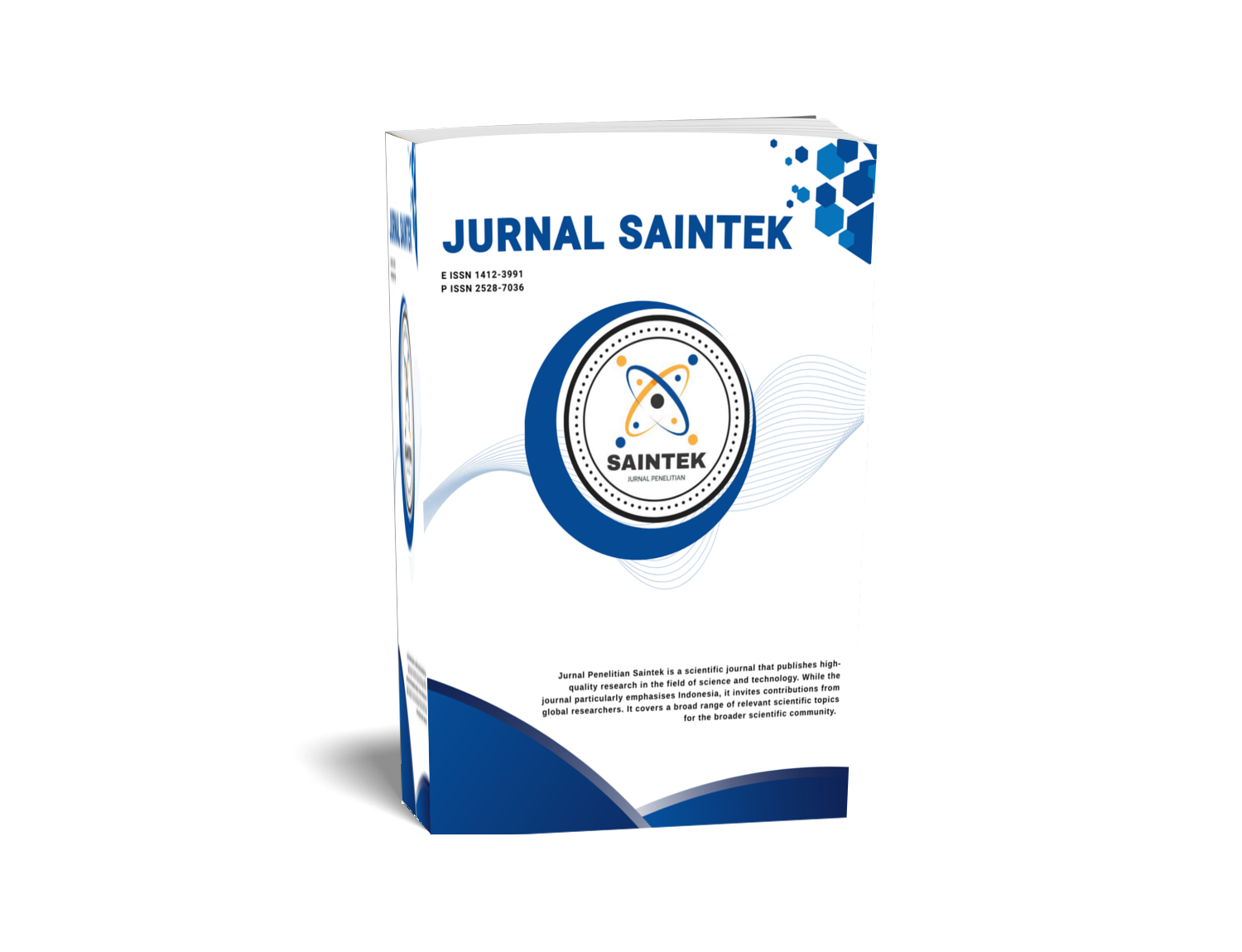Uji dan identifikasi aktivitas antioksidan isolat BAL CIN-2 hasil isolasi cincalok
DOI:
https://doi.org/10.21831/jps.v1i1.44187Keywords:
TLC, DPPH, metode fosfomolibdenum, spektrofotometer UV-Vis, FTIRAbstract
Test and identification of antioxidant activity of isolates LAB CIN-2 isolated from cincalok
This study aimed to test the antioxidants produced by LAB CIN-2 isolates using α,α-diphenyl-β-picrylhydrazyl (DPPH) and phosphomolybdenum methods, to identify antioxidant compounds produced by LAB CIN-2 isolates using the Thin Layer Chromatography (TLC) and UV-Vis spectrophotometer, as well as to analyse the antioxidant functional groups of LAB CIN-2 isolate using the Fourier Transform Infrared Spectroscopy (FTIR) method. The culture was grown on MRSA media and then the growth was observed on MRSB media for 72 hours, then analyzed using the specified method. TLC test results showed that LAB isolate CIN-2 produced four spots with an Rf value of 0.98; 0.91; 0.73; and 0.6. The DPPH test showed that the antioxidant properties of the supernatant isolates of LAB CIN-2 were very weak. The phosphomolybdenum method showed that the antioxidant content of the supernatant of LAB CIN-2 isolate was 1.906 mgAAE/ml. Analysis using a UV-Vis spectrophotometer produces 4 absorption waves with a maximum absorbance 3,943 at a wavelength of 290 nm. The test is suspected that the compounds contained in it are flavonoid compounds of the flavanone or dihydroflavonol group. Analysis using FTIR showed that antioxidant from supernatant of LAB isolate CIN-2 was suspected to contain flavonoid compounds with aromatic O-H and C=C functional groups. It can be concluded that supernatant from LAB CIN-2 isolates contains weak antioxidants in the form of compounds from the flavonoids group.
References
Akbar, H. R. (2010). Isolasi dan identifikasi golongan flavonoid daun dandang gendis (Clinacanthus nutans) berpotensi sebagai antioksidan (Skripsi tidak diterbitkan). Departemen Kimia, Fakultas MIPA, Institut Pertanian Bogor, Bogor.
Aliyu, M. A., Abdullahi, A. A., & Ugya, A. (2017). Antioxidant properties of selected poaceae species in Kano, Northern Nigeria. European Journal of Biomedical and Pharmaceutical Sciences, 4(5), 577-585.
Aloanis, A. A., & Karundeng, M. (2019). Total kandungan antioksidan ekstrak etanol buah beringin (Ficus benjamina Linn.). Fullerene Journal of Chemistry, 4(1), 1-4.
Amaral, V. A., Alves, T. F. R., de Souza, J. F., Batain, F., deMoura Crescencio, K. M., Soeiro, V.S., de Barros, C. T., & Chaud, M. V. (2020). Phenolic compounds from Psidium guajava (Linn.) leaves: Effect of the extraction-assisted method upon total phenolics content and antioxidant activity. Biointerface Research in Applied Chemistry, 11(2), 9346-9357. https://doi.org/10.33263/BRIAC112.93469357.
Arfah, A. (2019). Isolasi dan identifikasi fungi endofit daun dan umbi bawang dayak (Eleutherine palmifolia Merr) sebagai penghasil senyawa antioksidan. Journal of Pharmaceutical Science and Herbal Technology, 4(1), 32-39.
Arifin, B., & Ibrahim, S. (2018). Struktur, bioaktivitas dan antioksidan flavonoid. Jurnal Zarah, 6(1), 21-29.
Aritonang, S. N., Roza, E., Rossi, E., Purwati, E., & Husmaini, H. (2017). Isolation and identification of lactic acid bacteria from okara and evaluation of their potential as candidate probiotics. Pakistan J. Nutri, 16(8), 618-628.
Bisson, L. (2001). The alcoholic fermentation section 3. University of California.
Chalid, S. Y., & Hartiningsih, F. (2013). Potensi dadih susu kerbau fermentasi sebagai antioksidan dan antibakteri. Prosiding SEMIRATA 2013, 1(1), 369-375.
Dachriyanus. (2004). Analisis struktur senyawa organik secara spektroskopi. Lembaga Pengembangan Teknologi Informasi dan Komunikasi (LPTIK) Universitas Andalas, Padang.
Lade, B. D., Patil, A. S., Paikrao, H. M., Kale, A. S., & Hire, K. K. (2014). A comprehensive working, principles and applications of thin layer chromatography. Res. J. Pharm. Bio. Chem. Sci, 5(4), 486-503.
Manguntungi, B., Saputri, D. S., Mustopa, A. Z., Ekawati, N., Nurfatwa, M., Prastyowati, A., Irawan, S., Vanggy, L. R., & Fidien, K. A. (2020). Antidiabetic, antioxidants and antibacterial activities of Lactic Acid Bacteria (LAB) from masin (Fermented sauce from Sumbawa, West Nusa Tenggara, Indonesia). Annales Bogorienses, 24(1), 27-34).
Markham, K. R. (1998). Cara mengidentifikasi flavonoid. (Terj.: Padmawinata). Penerbit ITB.
Molyneux, P. (2004). The use of the stable free radical diphenylpicrylhydrazyl (DPPH) for estimating antioxidant activity. Songklanakarin J. Sci. Technol, 26(2), 211-219.
Nofiani, Risa and Puji Ardiningsih. (2018). Physicochemical and Microbiological Profiles of Commercial Cincalok from West Kalimantan. JPHPI, 21(2), 244-250
Parwata, I. M. O. A. (2016). Antioksidan (Bahan ajar). Program Pascasarjana Universitas Udayana, Bali.
Pratiwi, E., Hasanah, U., & Idramsyah. (2014). Identifikasi senyawa metabolit sekunder pada jamur endofit dari tumbuhan raru (Cotylelobium melanoxylon). Prosiding Seminar Nasional Biologi dan Pembelajarannya (pp. 267-277).
Pribadhi, A. N., Kusdiyantini, E., & Ferniah, R. S. (2021). Isolasi dan karakterisasi bakteri asam laktat dari pangan fermentasi cincalok sebagai penghasil gamma-aminobutyric acid. Jurnal Bioteknologi & Biosains Indonesia (JBBI), 8(1), 25-32.
Prieto, P., Pineda, M., & Aguilar, M. (1999). Spectrophotometric quantitation of antioxidant capacity through the formation of a phosphormolybdenum complex: Specific application to the determination of vitamin E. Analytical Biochemistry, 269(2), 337-341.
Rahmawati, A., Kuswandi, B., & Retnaningtyas, Y. (2015). Deteksi gelatin babi pada sampel permen lunak jelly menggunakan metode Fourier Transform Infra Red (FTIR) dan kemometrik. Pustaka Kesehatan, 3(2), 278-283.
Rahmayani, U., Pringgenies, D., & Djunaedi, A. (2013). Uji aktivitas antioksidan ekstrak kasar keong bakau (Telescopium telescopium) dengan pelarut yang berbeda terhadap metode DPPH (diphenyl picril hidrazil). Journal of Marine Research, 2(4), 36-45.
Sankari, G., Krishnamoorthy, E., Jayakumaran, S., Gunasekaran, S., Priya, V. V., Subramaniam, S., & Mohan, S. K. (2010). Analysis of serum immunoglobulins using Fourier transform infrared spectral measurements. Biology and Medicine, 2(3), 42-48.
Sarwono, J. (2006). Metode penelitian kuantitatif dan kualitatif. Graha Ilmu.
Selly, A. J. (2008). Karakteristik sifat fisika-kimia dan pengujian antiproliferasi ekstraksi buah merah (Pandanus conoideus Lam.) terhadap sel kanker HeLa dan K-562 secara in vitro. (Skripsi tidak diterbitkan). Institut Pertanian Bogor, Bogor.
Sofiana, M. S. J., Warsidah, N. I., Nurdiansyah, S. I., Aritonang, A. B., Rahmawati, A., & Fadly, D. (2020). The activity of lactic acid bacteria from ale-ale (fermented clams) and cincalok (fermented shrimp) as antioxidant and antimicrobial. Systematic Reviews in Pharmacy, 11(12), 1676-1679.
Thirumurugan, D., Cholarajan, A., Raja, S. S. S., & Vijayakumar, R. (2018). An introductory chapter: Secondary metabolites. Dalam R. Vijayakumar & S. S. S. Raja (Eds.), Secondary metabolites - Sources and Applications. Intech Open. DOI: 10.5772/intechopen.79766.
Wulandari, D., & Purwaningsih, D. (2019). Identifikasi dan karakterisasi bakteri amilolitik pada umbi Colocasia esculenta L. secara morfologi, biokimia, dan molekuler. Jurnal Bioteknologi dan Biosains Indonesia, 6(2), 247-258.
Wulandari, L. (2011). Kromatografi lapis tipis. PT. Taman Kampus Presindo.
Yassa, N., Masoomi, F., Rankouhi, S. R., & Hadjiakhoondi, A. (2015). Chemical composition and antioxidant activity of the extract and essential oil of Rosa damascena from Iran, population of Guilan. DARU Journal of Pharmaceutical Sciences, 17(3), 175-180.
Downloads
Published
How to Cite
Issue
Section
Citation Check
License
Who Can Submit?
Any individual may submit an original manuscript for consideration for publication in Jurnal Penelitian Saintek as long as they hold the copyright to the work or are authorized by the copyright owner(s) to submit it. Authors retain initial ownership of the copyrights to their works prior to publication, except in cases where, as a condition of employment, they have agreed to transfer copyright to their employer.
User Rights
Jurnal Penelitian Saintek is an Open Access journal. Users are granted the right to read, download, copy, distribute, print, search, or link to the full texts of articles, provided they comply with the conditions of the Creative Commons Attribution-ShareAlike License 4.0 (CC BY-SA 4.0).
https://creativecommons.org/licenses/by-sa/4.0/
Author Rights
Authors retains copyrights.
Jurnal Penelitian Saintek by http://journal.uny.ac.id/index.php/saintek is licensed under a Creative Commons Attribution-ShareAlike 4.0 International License.









